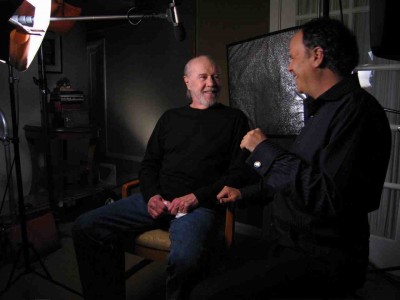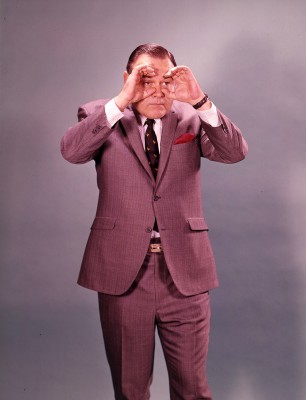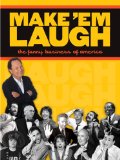| Reviews & Columns |
|
Reviews DVD TV on DVD Blu-ray 4K UHD International DVDs In Theaters Reviews by Studio Video Games Features Collector Series DVDs Easter Egg Database Interviews DVD Talk Radio Feature Articles Columns Anime Talk DVD Savant Horror DVDs The M.O.D. Squad Art House HD Talk Silent DVD
|
DVD Talk Forum |
|
|
| Resources |
|
DVD Price Search Customer Service #'s RCE Info Links |
|
Columns
|
|
|
Make 'Em Laugh: The Funny Business Of America
And yet Make 'Em Laugh is an unmitigated disaster of a documentary. The six-part series squanders a mountain of incredible raw material in myriad ways, though chiefly by trying to cover too much ground in too little time, and because of some incredibly bad decision-making about how to organize everything. It's almost heartbreaking to watch: we may never see so many postwar comedians interviewed for a program like this again - George Carlin and Dick Martin appear in what amounts to their last interviews - and the cost of licensing as many varied clips as Make 'Em Laugh does has become prohibitively expensive, far beyond the reach of most filmmakers. What should have been a definitive program exploring the art of American comedy instead has all the lasting impact of a Dick Clark "TV's Funniest Bloopers" special.
Limiting the scope of the series to, say, American film comedy would be daunting enough given the constraints of just six 53-minute shows. But Make 'Em Laugh's writers' free association approach attempts to cover far more ground than it possibly can handle. Included are profiles of silent film comedians, sitcom stars, political satirists, stand-up comedians, radio comedians, underground comedy album stars. During the last episode the show goes off on wild tangents to discuss Bill Gaines' Mad Magazine and Billy Crystal's Oscar-hosting performances. (Crystal also appears in unneeded, obvious prologues to each episode.)
In trying to be all-encompassing, no topic is served well. Meanwhile, innumerable performers are grievously short-changed or not mentioned at all. Mad is profiled but not The New Yorker, the writings of James Thurber, Dorothy Parker or any member of the Algonquin Round Table. Lucille Ball is profiled twice, on two different shows, first in an episode about domestic sitcoms, then again in a show about slapstick, but Ball was really a serious film actress who did comedy well. Yet contemporaries like Ann Sothern, Claudette Colbert, Judy Holliday, and Betty Hutton go unmentioned, as do women who were first and foremost comediennes, say Fanny Brice (glimpsed fleetingly) and Judy Canova (unmentioned). If Lucy merits such attention what about Jack Lemmon? Where's Walter Matthau?
Film Comedians are everywhere - though both Harry Langdon and Charley Chase are conspicuously absent - and yet because this is a performer-based series there's no sign at all of the great comedies of Preston Sturges, Howard Hawks, Billy Wilder, or Ernst Lubitsch. The series explores Woody Allen's stand-up career but ignores his movies completely. An episode about sitcoms basically snubs single-camera shows in favor of three-camera sitcoms (with domestic settings) filmed before an audience, excluding several influential sitcoms. And on and on.
Instead of breaking the series up into vaguely chronological episodes, or perhaps sorting everything by medium (radio, comedy albums, television, etc.) the writers unwisely tried to categorize comedy thusly:
Episode 1: "Would Ya Hit a Guy with Glasses?: Nerds, Jerks, & Oddballs"
Episode 2: "Honey, I'm Home: Breadwinners and Homemakers"
Episode 3: "Slip on a Banana Peel: The Knockabouts"
Episode 4: "When I'm Bad, I'm Better: The Groundbreakers"
Episode 5: "Never Give a Sucker an Even Break: The Wiseguys"
Episode 6: "Sock it to Me? Satire and Parody"
No matter that not all comedians neatly fall into one of these categories, or straddled more than one. The result are shows that unconvincingly cosmically link silent comedian Harold Lloyd to Cheech & Chong (in episode 1), and Will Rogers to Laugh-In (episode 6). Predictably, W.C. Fields is lumped in with other "Wiseguys" (along with, inexplicably, Jack Benny - Jack Benny?!) yet even when one of the interview subjects points out that Fields' best movies had him playing a completely different character, the hen-pecked husband, the film clips still show only the familiar caricature of Fields: the boozing child-hater. Similarly, clips from The Honeymooners reveal only the blustery, "To the moon, Alice!" side of Ralph Kramden (Jackie Gleason), not the contrite, adoring husband and loveable loser that was so critical to that character's appeal.
Indeed, throughout Make 'Em Laugh, clips are inaptly or inappropriately used. Narrator Amy Sedaris talks about W.C. Fields' career at Paramount Pictures while a clip from the Mack Sennett production of The Dentist is shown; when Sedaris talks about how the Production Code thwarted Fields' salacious double-entendres, a clip from the salacious, pre-code International House (1933) is onscreen.
"The Knockabouts" tries to cover Chaplin, Keaton, Laurel & Hardy, The Three Stooges, and Martin & Lewis all in one show, but rather than exemplify their individual appeal through representative clips, the people behind Make 'Em Laugh assume their audience won't have the patience to sit through a film clip longer than 20 seconds. It's one thing to take a Groucho one-liner out of context (it's still funny), but Laurel & Hardy's humor builds slowly, deliberately, drawing heavily from their childlike characterizations. In Make 'Em Laugh it's presented only in fast-paced montages highlighting pratfalls and sound effects, suggesting The Two Stooges more than the Stan & Babe loved the world over.
Worse, about 75% of older film clips are cropped to fit the 16:9 format of the show. The producers of Make 'Em Laugh don't seen to understand how utterly ruinous this is for the comedy in older films like The Music Box The Bank Dick and Duck Soup; it's like cropping a dance routine from Top Hat for widescreen televisions and chopping Fred and Ginger off at the knees. Frequently the Telecine operator has to artificially pan or tilt to capture a sight gag, but the timing is thrown and all the comedy is sucked out in the process.
The research seems slipshod. The Marx Bros. section is like a Cliffnotes version of better Marx Bros. shows. (Here, Sederis calls Chico Marx "Cheeko" instead of the correct "Chicko.") A segment on The Dick Van Dyke Show plays like it was cribbed from the DVD set that came out a few years ago.
If it were not for the observations of its numerous interview subjects and the frequently fascinating things they say, Make 'Em Laugh would be nearly unwatchble. Beyond the usual suspects (Billy Crystal, Lorne Michaels, Leonard Maltin), it's an especially great pleasure to see people like Shelley Berman, Mort Sahl, pioneering female stand-up artists like Phyllis Diller, as well as '70s and '80s artists less visible in today's environment. Unfortunately, many like Caesar are on so briefly you wonder why they were interviewed at all.
There are good clips, too: rare footage of Tom Lehrer performing, Steve Allen and Mort Sahl on a televised debate about comedy and censorship, film clips from the never-released-to-home video Top Banana (1954) with Phil Silvers and the unjustly forgotten landmark sitcom The Goldbergs.
Video & Audio
We received only check discs for Make 'Em Laugh with no final packaging. There are two shows on each of the three single-sided discs. The shows are 16:9 enhanced, which is great for the material intended to be seen widescreen, but most everything, including '50s kinescopes and '30s two-reel comedies have been reformatted to fit the screen, and the results are pointlessly, eye-strainingly awful. Even a brief clip from Mel Brooks's filmed-in-Panavision Blazing Saddles has been cropped to 1.78:1 widescreen.
Extra Features
Supplements are limited to Extended Interviews but they're not extended all that much. Most run less than a minute, with some closer to 30 seconds. I for one would have loved to see raw interview footage with, for example, Dick Van Dyke or Sid Caesar, but what's there are brief little snippets that didn't make the final cut.
Parting Thoughts
Make 'Em Laugh - The Funny Business of America is crammed with funny clips, and both infectious admiration for great talent and astute observations by its interview subjects, and yet the show is a major failure due to extremely bad organization and production decisions that greatly undermine its enormous potential. Rent It.
Film historian Stuart Galbraith IV's latest book, The Toho Studios Story, is on sale now.
|
| Popular Reviews |
| Sponsored Links |
|
|
| Sponsored Links |
|
|
| Release List | Reviews | Shop | Newsletter | Forum | DVD Giveaways | Blu-Ray | Advertise |
|
Copyright 2024 DVDTalk.com All Rights Reserved. Legal Info, Privacy Policy, Terms of Use,
Manage Preferences,
Your Privacy Choices | |||||||
















